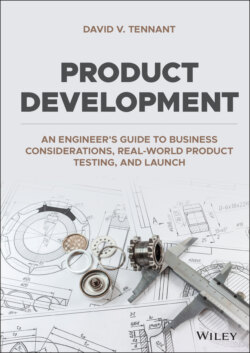Читать книгу Product Development - David V. Tennant - Страница 11
1 Introduction to Product Development
ОглавлениеMy formal academic training began as a student of mechanical engineering. Simultaneously, I worked part-time as a designer to pay for my education. In this case, my work allowed me to see how products were developed to the lower level where I was doing the technical drawing. And my engineering education helped me learn the limits of materials, think about product technical features, and how to apply mathematical formulas to solve technical problems.
However, nowhere did I learn about how products are really developed. What drives a company to success? How do companies know which products will be accepted in the marketplace? What is a marketplace or a market segment? As a result, my education and early work experience taught me a lot about applying engineering principles, but I had no knowledge of marketing, sales, business finance, C-level executive support, or how R&D (research and development) and the other areas are supposed to all work together. I simply (and naively) believed that new products were developed and launched by the engineering department. The product that had the better design would always be preferred by consumers.
Since those days in college, and my early career in engineering, I have come a long way to understanding that product development is a multi-faceted effort involving many diverse groups and talents. It is so much more than R&D or engineering.
Similarly, I have noticed that other disciplines – marketing, sales, etc. – do not always understand the engineering or R&D process in product development, which can be equally frustrating for those on the business side of a company.
The underlying purpose of this book is to serve as a bridge between the various groups that are responsible for developing and launching new products and services. It will assist engineering students, marketing professionals, R&D scientists, and product developers in how to effectively plan and launch new products.
This does not mean your future projects will all be successful: the market determines who survives and who doesn’t. However, the techniques, methods, and studies in this book can help you determine which projects should go forward and how to best plan and execute a flawless development and launch. And which projects should be scrapped early in the development process. Half of the key is knowing which projects have a greater chance of success vs. those that don’t. To illustrate important points, case studies will be provided that illustrate real-life failures and successes that reinforce the principles in this book. This book is very practical and does not dwell on theory or untested ideas.
Figure 1.1, Core Team in Product Development, illustrates some of the various functional areas and their interaction in product development. This figure is dynamic, so the participants will change depending on the type of product, its complexity, and it’s corporate visibility or priority.
Figure 1.1 Core Team – Product Development.
It should also be noted that product development will require market research, data analytics, realistic objectives, project management, and leadership.
